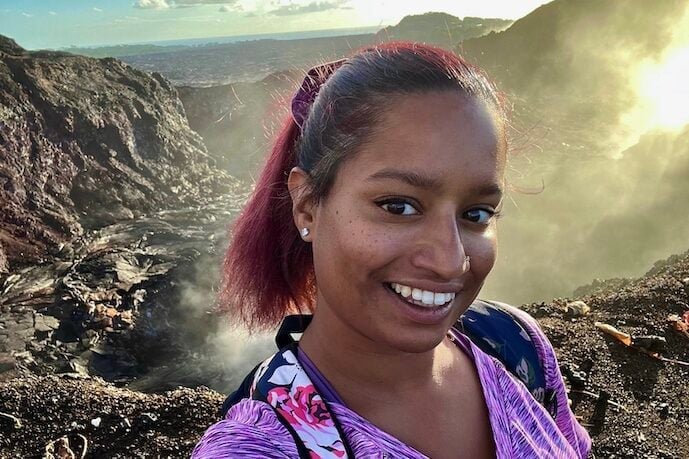By studying the tiniest forms of life around the world, microbiologists like Pia Sen, Ph.D. student in biological sciences at The George Washington University, are helping us understand more about life at the extreme. Sen is focusing on creatures that love super-hot environments, also known as thermophiles. She studies how these thermophiles work together and communicate to survive in locations that would be dangerous to humans, such as volcanic steam vents and hot springs.
We asked her a few questions to learn about her life in the lab and around volcanoes, and why tiny creatures caught her attention.
1. To start off, what is a microbe?
Microbes are small living organisms. I think they’re cool because they operate like little machines to accomplish cool things! Microbes can do almost anything from surviving in volcanoes to degrading nuclear waste in power plants. Microbes also play a role in our day-to-day life; they exist in our guts and on our skin, helping our bodies function. They’re also important for helping plants to grow and the ocean to stay healthy. So, microbes are pretty much everywhere, but I’m interested in extremophiles that can survive in environmental extremes.
2. What made you want to study microbiology?
I actually started high school wanting to be a mechanical engineer. I did robotics in high school and I loved building things with my hands, machine shop, and electronics. It was cool to see how things worked. In 9th-grade biology, I began to see microbes the same way. They have reasons for why they do things the way they do: when you are that small, it is so important to be efficient with your energy. Microbes are so well-engineered; they gain and lose traits quickly to become well-designed machines, and I think we have a lot to learn from them.
3. Where can we find microbes in our everyday lives?
Microbes are everywhere! They help us digest food—without microbes, we wouldn’t be able to eat and obtain nutrients. They help protect us against invasive pathogens (the ‘bad’ bacteria) on our skin, and they even help babies develop in the womb. They help plants grow in the soil and they even help create oxygen for us to breathe.
4. What is your daily work like as a microbiologist?
As a Ph.D. student, my schedule can change based on the day and time of year. Some days, I come to school and take classes, then go to the lab and run experiments. Other days, I work as a teaching assistant for college biology, or I’m in the field, usually in remote places such as the Big Island of Hawaii or the hot springs of the West Coast U.S. The coolest thing I’ve ever gotten to do had to be going into a volcanic fissure and lava tube cave in Hawaii to sample the microbes there. I had never been to an island before.
5. Why is it important to understand microbes, especially ones in extreme environments?
If we understand how these microbes survive in extreme environments, we can learn from them and adapt their technology to help us as humans. Microbes are smart. They have to be efficient because when you’re that small, you need to use your energy well. If we understand how microbes can break down nuclear radiation and survive in volcanoes to later make the soil rich and fertile in places like Hawaii, we can try to copy them and engineer them to do that. This could help us with adapting to conditions like climate change.
6. How can students start learning about microbiology now?
My biggest advice to aspiring microbiologists is to just get started. It doesn’t matter if you aren’t sure that you’re ‘good at science’ or ‘talented at math.’ All you need to really have is curiosity and passion. I think it’s important to support that creativity. As a kid, I had a little corner where I would play with popsicle sticks and straws to build my own devices. I didn’t think that was science, but now I can recognize how it helped shape my skills
7. How can students start learning about microbiology now?
My biggest advice to aspiring microbiologists is to just get started. It doesn’t matter if you aren’t sure that you’re ‘good at science’ or ‘talented at math.’ All you need to really have is curiosity and passion. I think it’s important to support that creativity. As a kid, I had a little corner where I would play with popsicle sticks and straws to build my own devices. I didn’t think that was science, but now I can recognize how it helped shape my skills.

